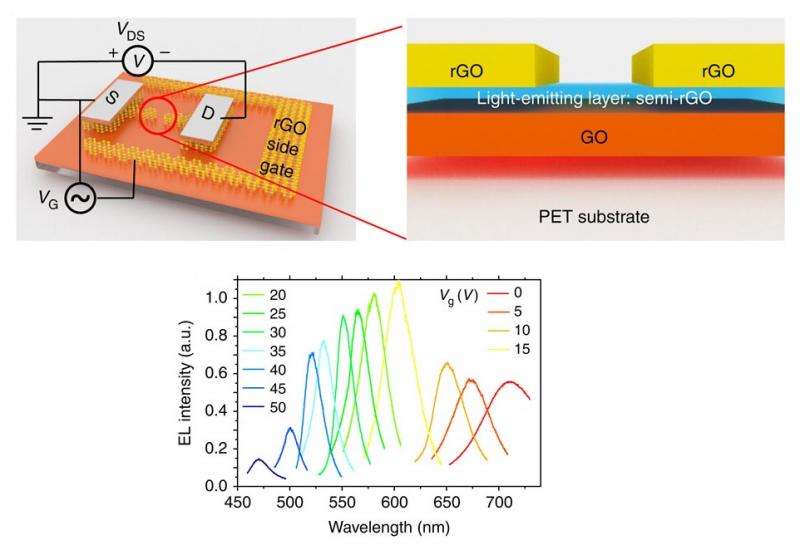July 28, 2015 feature
Scientists demonstrate first color-tunable and first graphene-based LED

(Phys.org)—Currently, all light-emitting diodes (LEDs) emit light of only one color, which is predefined during fabrication. So far, tuning the color of light produced by a single LED has never been realized, despite numerous attempts.
So it's quite remarkable that in a new study, scientists have demonstrated an LED that not only can be tuned to emit different colors of light, but can do so across nearly the entire visible spectrum: from blue (450-nm wavelength) to red (750-nm wavelength)—basically all colors but the darkest blues and violets.
The key to achieving the color-tunable LED is making it out of graphene—the same material that has led to groundbreaking research in a number of areas, from batteries to solar cells to semiconductors. Despite graphene's success in these areas, graphene-based LEDs have never been realized before now, making the new device the first-ever graphene-based LED in addition to being the first color-tunable LED.
Applications of the new LED include high-quality, color-tunable LED displays for TVs and mobile devices, color-tunable LED light fixtures, and the potential for a variety of future graphene-based photonic devices.
Blending two forms of graphene
The researchers, led by Professor Tian-Ling Ren at Tsinghua University in Beijing, made the light-emitting material from the interface of two different forms of graphene. These forms are graphene oxide (GO), which is produced from inexpensive graphite, and reduced graphene oxide (rGO), which is a more pristine form of GO.

Lying at the interface of the GO and rGO is a special type of partially reduced GO that has optical, physical, and chemical properties that lie somewhere in between those of GO and rGO. The most important "blended" property of the interfacial layer is that it has a series of discrete energy levels, which ultimately allows for the emission of light at many different energies, or colors.
The occurrence of this property is especially interesting because, on their own, neither GO nor rGO (or any other known form of graphene, for that matter) can emit any light at all. This is because neither material has the right size "bandgap," which is the gap between two energy bands that electrons must jump across to conduct electricity or emit light. While GO has an extremely large bandgap, rGO has a zero bandgap.
Instead of having a bandgap somewhere in between GO and rGO, the partially reduced interfacial GO actually has many different intermediate bandgaps as a result of how the blending occurs—not as a smooth transition, but in the form of rGO nanoclusters embedded within the GO layer. Because these rGO nanoclusters are reduced to varying degrees at the interface, they exhibit variations in their energy levels and, consequently, in the color of emitted light. These energy levels can be easily modulated by changing the applied voltage or by chemical doping, which selectively stimulates a single color of luminescence and enables tuning of the LED's color.
"We found that a combination of GO and rGO can create a conductive and wide bandgap material," Ren told Phys.org. "It is commonly known that graphene does not have a bandgap. Therefore we were all surprised that our GO/rGO interface (a graphene-based system) can actually be luminescent."
Commercial expectations
The fact that this is the first observation of luminescence in a graphene-based system paves the way toward using graphene as a light source in future graphene-based photonic devices. A color-tunable LED has also been highly desired for high-quality LED displays and light fixtures. Because the color changes in response to certain chemicals, the devices could also have sensing applications.
"Graphene-based, color-tunable LEDs can enable the realization of flexible display technologies that can cover the entire visible spectrum," Ren said. "Conventional LEDs only emit a fixed wavelength of light and thus display technologies require a mixture of red, green, and blue LEDs. If a graphene-based, color-tunable LED is used, a full-color and flexible display can be realized in a simple way. A wide range of consumer and medical electronics can benefit from such a technology."
In their work, the researchers designed, fabricated, and tested 20 graphene-based LEDs. Overall, the devices demonstrated good brightness but low efficiency, which they plan to improve. Another drawback of the current prototype is a very short emission lifetime of less than a minute or so in ambient conditions and about 2 hours in vacuum. The researchers attribute the short lifetime to oxidation in the air and predict that protective coatings may improve this area.
Despite the room for improvement, the researchers expect the graphene-based LEDs to have encouraging commercial prospects due to several advantages, including their precise color tunability, compact structure, and straightforward fabrication.
"The efficiency of the graphene LED could be improved further," Ren said. "One way to achieve this would be by using n-type [semiconductor] materials combined with graphene. The short lifetime could also be improved by vacuum sealing. Commercialization may be expected in a few years since our method is simple and low-cost. As with any other technological development coming out of a lab, challenges exist; however, we believe these challenges can be overcome in the near future. We believe that graphene-based, color-tunable LEDs are a promising technology for flexible displays."
More information: Xiaomu Wang, et al. "A spectrally tunable all-graphene-based flexible field-effect light-emitting device." Nature Communications. DOI: 10.1038/ncomms8767
Journal information: Nature Communications
© 2015 Phys.org



















